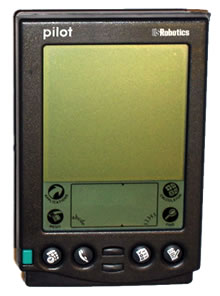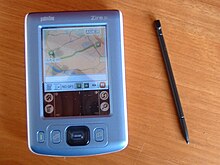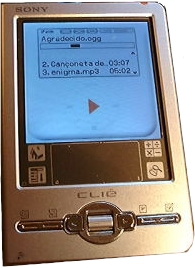This is a list of Palm OS devices, and companies that make, or have made, them.
Fossil , made Wrist PDAs that use the Palm OS operating system.(Discontinued)
S10/S11/S12—Palm OS 4.1 - first Chinese Palm
S50/S55—Palm OS 4.1, color Hi-Res screen
S60/S65—Palm OS 4.1, MP3 player, voice recorder, color Hi-Res screen Dana —Palm OS 4.1.2 - small "laptop" running Palm OS with a 560x160 pixel greyscale LCD, full-sized keyboard, two SD card slots, 8MiB or 16Mib memory, powered by NiMH or 3 x AA battery or wall adapterDana Wireless —Palm OS 4.1.2, same features as Dana plus Wi-Fi, 16MiB memory, SDIO support, widescreen launcherPDA with integrated GPS.
Smartphones with Palm OS [1]
Xplore G18 —Palm OS 4.1 (candybar, 2.2" 176x240 16-bit TFT, CIF camera, Dragonball VZ 33 MHz, 16MB RAM, 4MB OS flash)Xplore G88—Palm OS 4.1 (slider, 2.2" 176x240 16-bit TFT, CIF camera, Dragonball VZ 33 MHz, 16MB RAM, 4MB OS flash, 24MB user flash appearing as an internal SD card)
Xplore M28—Palm OS 5.4 (slider, 2.2" 176x240 16-bit TFT, VGA camera, ARM9 CPU, 32MB NVFS storage, SD/MMC card slot)
Xplore M68—Palm OS 5.4 (candybar, 2.2" 176x240 16-bit TFT, 1.3MP camera, ARM9 CPU, SD/MMC card slot)
Xplore M70—Palm OS 5.4 (candybar, 2.2" 176x240 16-bit TFT, 1.3MP camera with video recording, ARM9 CPU, SD/MMC card slot)
Xplore M70S—Palm OS 5.4 hardware same as M70 with security firmware update
Xplore M98 —Palm OS 5.4 (flip, 2.2" 176x240 16-bit TFT inside, 96x96 outside, 1.3MP camera, ARM9 CPU, 32MB NVFS storage, microSD card slot)TRGpro —Palm OS 3.5.3 - introduced standard (CF) Card slot (company was at that time TRG (Technology Resource Group))Handera 330 —Palm OS 3.5.3Handera 330c — never releasedThe inventors of the Palm formed a new company called Handspring in June 1998, operating until 2003 when it merged with Palm, Inc.'s hardware division.
Visors introduced color cases and the Springboard Expansion slot.
Visor Solo —Palm OS 3.1H - 16 MHz, 2 MB RAM, B&W Visor Deluxe —Palm OS 3.1H/H2 - 20 MHz, 8MB RAM, B&W Visor Platinum —Palm OS 3.5.2H - 33 MHz, 8 MB RAM, B&W Visor Prism —Palm OS 3.5.2H3 - 33 MHz, 8 MB RAM, color (world's first 16-bit color Palm OS device) Visor Edge —Palm OS 3.5.2H - 33 MHz, 8 MB RAM, B&W, thin, sleek, metal case Visor Neo —Palm OS 3.5.2H3 - 33 MHz, 8 MB RAM, B&W Visor Pro —Palm OS 3.5.2H3 - 33 MHz, 16 MB RAM, B&W Smartphones (except 90)
The Treo 300 Treo 90 —Palm OS 4.1H - can be updated to 4.1H3 which adds SDIO support Treo 180 —Palm OS 3.5.2HTreo 180g —Palm OS 3.5.2H - the Treo 180 with Graffiti area, rather than a keyboard Treo 270 —Palm OS 3.5.2HTreo 300 —Palm OS 3.5.2H6.2Treo 600 —Palm OS 5.2.1HIBM WorkPad c3 IBM's Workpad series was nearly identical to PDAs manufactured by Palm. The main difference were color and logo on the casing.
WorkPad
Janam
XP20—Palm OS 5.4.9, B&W 160x160 screen, two variants: one with a full keyboard, one with partial
XP30—Palm OS 5.4.9, Color 240x160 screen, two variants: one with a full keyboard, one with partial Smartphones
Chinese PDAs
p100—Palm OS 5.3
p200—Palm OS 5.3
p300—Palm OS 5.3 A Palm Pilot 5000 Pilot 1000 (as division of U.S. Robotics )—Palm OS 1.0 - 16 MHz, 128 KB RAM Pilot 5000 (as division of U.S. Robotics )—Palm OS 1.0 - 16 MHz, 512 KB RAM PalmPilot Personal (as division of U.S. Robotics )—Palm OS 2.0 - 16 MHz, 512 KB RAM, backlight PalmPilot Professional (as division of U.S. Robotics )—Palm OS 2.0 - 16 MHz, 1 MB RAM, backlight Palm III —Palm OS 3.0 - 16 MHz, 2 MB RAM (update possible to 3.5.3 (website) or 4.1 (CD))Palm IIIx —Palm OS 3.1 - 16 MHz, 4 MB RAM (update possible to 3.5.3 (website) or 4.1 (CD))Palm V —Palm OS 3.1 - 16 MHz, 2 MB RAM, thin, sleek, metal case (update possible to 3.5.3 (website) or 4.1 (CD))Palm VII —Palm OS 3.2 - 16 MHz, 2 MB RAM, Palm.net wireless Palm IIIe —Palm OS 3.1 - 16 MHz, 2 MB RAM, no flash OS upgrade Palm Vx —Palm OS 3.3 - 20 MHz, 8MB RAM, thin, sleek, metal case (update possible to 3.5.3 (website) or 4.1 (CD))Palm IIIxe —Palm OS 3.5 - 16 MHz, 8 MB RAM (update possible to 3.5.3 (website) or 4.1 (CD))Palm IIIc —Palm OS 3.5 - 20 MHz, 8 MB RAM, Palm's first color screen (8-bit) (update possible to 3.5.3 (website) or 4.1 (CD))Palm VIIx —Palm OS 3.5 - 20 MHz, 8 MB RAM, Palm.net wireless Palm m100 —Palm OS 3.5 - 16 MHz, 2 MB RAM Palm m105 —Palm OS 3.5 - 16 MHz, 8 MB RAM Palm m500 —Palm OS 4.0 - 33 MHz, 8 MB RAM, thin, sleek, metal case (update possible to 4.1 (website)) [ 1] Palm m505 —Palm OS 4.0 - 33 MHz, 8 MB RAM, 16-bit color screen, thin, sleek, metal case (update possible to 4.1 (website)) [ 1] Palm m125 —Palm OS 4.0.1 - 33 MHz, 8 MB RAM Palm i705 —Palm OS 4.1 - 33 MHz, 8 MB RAM, Palm.net wireless Palm m130 —Palm OS 4.1 - 33 MHz, 8 MB RAM, 12-bit color screen [ 2] Palm m515 —Palm OS 4.1 - 33 MHz, 16 MB RAM, 16-bit color screen, thin, sleek, metal case The Zire series, renamed "Z" series in 2005, are the lower-end Palm models. Some have color screens (160x160 or 320x320), some are B&W (160x160).
The palmOne Zire 31 and stylus Zire (also known as m150)—Palm OS 4.1 - 16 MHz, 2 MB RAM Zire 71 —Palm OS 5.2.1 - 144 MHz, 16 MB RAM, 0.3MP digital camera, MP3 player Zire 21 —Palm OS 5.2.1 - 126 MHz, 8 MB RAM, new PIM Zire 31 —Palm OS 5.2.8 - 200 MHz, 16 MB RAM, new PIM, MP3 player Zire 72 & 72s —Palm OS 5.2.8 - 312 MHz, 32 MB RAM, new PIM, 1.2MP digital camera with video, voice recorder, MP3 player, Bluetooth Palm Z22 —Palm OS 5.4.9 - 200 MHz, 32 MB RAM, new PIM, NVFS The Tungsten series, renamed "T" series in 2005, are the high-end Palm models, with ARM/RISC processors (except the Tungsten W), high-resolution color screens, and SD memory cards.
Tungsten T (also known as m550)—Palm OS 5.0 - 144 MHz, 16 MHz, sliding case, voice recorder, Bluetooth Tungsten W —Palm OS 4.1.1 - 33 MHz, 16 MB RAM, physical keyboard, cell service (update possible to 4.1.2 (website))Tungsten C —Palm OS 5.2.1 - 400 MHz, 64 MB RAM, physical keyboard, voice recorder, WiFi Tungsten T2 —Palm OS 5.2.1 - 144 MHz, 32 MB RAM, voice recorder, Bluetooth Tungsten E —Palm OS 5.2.1 - 126 MHz, 32 MB RAM, new PIM Tungsten T3 —Palm OS 5.2.1 - 400 MHz, 64 MB RAM, new PIM, sliding case, voice recorder, MP3 player, Bluetooth Tungsten T5 —Palm OS 5.4.0 - 416 MHz, 256 MB RAM, new PIM, NVFS , internal USB flash drive , MP3 player, Bluetooth (update possible to 5.4.8 (website)) [ 3] Tungsten E2 —Palm OS 5.4.7 - 200 MHz, 32 MB RAM, new PIM, NVFS , Bluetooth, MP3 player Palm TX —Palm OS 5.4.9 - 312 MHz, 128 MB RAM, new PIM, NVFS , MP3 player, WiFi, Bluetooth LifeDrive —Palm OS 5.4.8 - 416 MHz, 64 MB RAM, 4 GB Microdrive , new PIM, NVFS , voice recorder, MP3 player, WiFi, Bluetooth The Treo series are combo cell phones/PDA models, originally developed by Handspring.
Treo 600 —Palm OS 5.2.1H (The first models were "Handspring"-branded, later models were "Palm"-branded.)Treo 650 —Palm OS 5.4, 5.4.5 or 5.4.8 depending on specific carrier versionTreo 680 —Palm OS 5.4.9Treo 700p —Palm OS 5.4.9Treo 755p —Palm OS 5.4.9Palm P850 —Palm OS 5.2H - released in 2010 in the Chinese market, also called the Treo P850 The Palm Centro is a combo cell phone/PDA, similar to the Treo line.
Made by Pitech
Smartphones, later sold to Kyocera
Smartphones
SPH-i300 —Palm OS 3.5SPH-i330 —Palm OS 3.5.3SCH-M330 —Palm OS 3.5.3 - Scheduled for release in South KoreaSPH-i500 —Palm OS 4.1SPH-i550 —Palm OS 5.2 - never released.SCH-M500 —Palm OS 5.2 - Scheduled for release in South Korea in mid-July 2004.[ 7] SGH-i500 —Palm OS 5.2 - never releasedSGH-i505 —Palm OS 5.2 - never releasedSGH-i530 —Palm OS 5.2 - never sold, only given away at Athens Olympics 2004SCH-i539 —Palm OS 5.4.1 - Released in ChinaSony developed and marketed the CLIÉ multimedia PDA from 2000 to 2005.
The Sony CLIÉ TJ37
N Series
PEG-NX60 —Palm OS 5.0 & MP3 playerPEG-NX70V —Palm OS 5.0 & MP3 player & VGA digi-cam / camcorderPEG-NX73V —Palm OS 5.0 & MP3 player & VGA digi-cam / camcorder (/E European versions also had Bluetooth)PEG-NX80V —Palm OS 5.0 & MP3 player & 1.3 Mp digi-cam / camcorderPEG-NZ90 —Palm OS 5.0 & MP3 player & 2 Mp digi-cam / camcorder
S Series
SJ Series
SL Series
PEG-SL10 —Palm OS 4.1 & B&W paper-white screen
T Series
PEG-T400 —Palm OS 4.1 & vibe-alarm feature thin, sleek, metal case , B&W HiRes screen (Japanese)PEG-T415 —English ROM version of the PEG-T400PEG-T425 —European version of T415PEG-T600C —Palm OS 4.1 thin, sleek, metal case , Color HiRes screen (Japanese)PEG-T615C —English ROM version of the PEG-T600PEG-T625C —European version of T615CPEG-T600C —Palm OS 4.1 & MP3 player thin, sleek, metal case , Color HiRes screenPEG-T665C —English ROM version of the PEG-T650PEG-T675C —European version of T665C
TG Series
TH Series
PEG-TH55 —Palm OS 5.2.1 Wi-Fi (/E European versions also had Bluetooth)
TJ Series
VZ Series
PDA with integrated barcode reader
A PDA designed for handheld gaming . It was held sideways (landscape), had an analog joystick and extra gaming buttons, and used Bluetooth for multiplayer gaming as well as standard PDA functions. It also introduced a dedicated video chip, and dual SD card slots.
Oswin
Two models (candybar and slider) were demonstrated at PalmSource Euro Dev Con 2005 running Palm OS Cobalt 6.1.1 [ 8]
Emulators
POSE (Palm OS Emulator) —Free Palm OS 4 emulator for PCsPalm OS Simulator —Palm OS 5 simulator for PCsStyleTap —for Windows Mobile, Symbian, and AndroidGarnet VM—for Access Linux Platform and Maemo
Classic—for webOS -based Devices
PHEM—for Android -based devices
Cloudpilot—for web browsers and mobile devices
See also
References
External links




